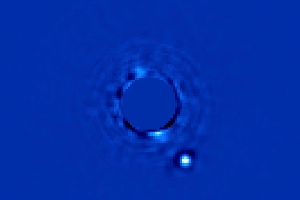May 19 2014
The hunt for planets in faraway solar systems has taken another step forward with the debut of a new planet-detecting instrument led by a Stanford physicist.
 The bright white dot is the planet Beta Pictoris b, glowing in the infrared light from the heat released when it was formed 10 million years ago. The bright star Beta Pictoris is hidden behind a mask at the center of the image. (Christian Marois, NRC Canada)
The bright white dot is the planet Beta Pictoris b, glowing in the infrared light from the heat released when it was formed 10 million years ago. The bright star Beta Pictoris is hidden behind a mask at the center of the image. (Christian Marois, NRC Canada)
The Gemini Planet Imager (GPI) has set a high standard for itself: The first image snapped by its camera produced the best-ever direct photo of a planet outside our solar system.
"We've been working on the Gemini Planet Imager for 10 years," said Bruce Macintosh, a Stanford professor of physics and the principal investigator on the international planet-hunting project. "We finally got it operational on the telescope last November and it worked beautifully right out of the box."
The scientists detailed the image in this week's publication of the Proceedings of the National Academy of Sciences.
The photo of Beta Pictoris b – as the planet is known – is more impressive considering that the planet is more than 63 light-years away from Earth. The planet is visible in a single 60-second exposure; with previous instruments it would have taken an hour. The combined GPI dataset revealed important details of the planet's orbit and axis and its relationship to a nearby asteroid belt.
It also allowed Macintosh's team to predict that in 2017 the planet may "transit" – pass directly in front of its parent star. Although the Kepler mission has discovered thousands of transiting planets, none has been directly seen. Direct observation of a planet as it transits its star would allow the planet to be studied in unprecedented detail.
Only a handful of planets have been directly imaged since construction began in 2004 on the GPI – a ground-based instrument at the Gemini South Telescope in Chile. The previous generation of adaptive optics, however, was only sensitive enough to observe planets that were much larger than Jupiter – three to 10 times Jupiter's mass – and only planets that were as far away from their stars as Saturn or Neptune is from our sun.
The GPI's advanced optics are tuned to detect faint planets orbiting very bright stars. This makes it possible to detect Jupiter-size planets orbiting closer to stars that are more like our own. Macintosh estimates that his team could be able to discover and characterize 20 to 50 planets.
"To some extent this is really the old looking-for-the-keys-under-the-searchlight joke," Macintosh said. "We look around bright nearby stars because we need the stars to be bright for GPI to work. But stars that are bright and close let you get lots more photons from the star and planet, and you can do a better job of understanding the planet."
The sensitive camera will be able to precisely measure the planet's temperature and chemical composition, which will allow for computer models of the atmosphere and climate to become much more exact. This information could then yield clues as to how the planet formed.
Unfortunately, the GPI won't be able to spot Earth-like planets; they're too small, and thus won't reflect enough light to be detected.
"But it's a step on the road," Macintosh said. "Some day a future space telescope will use the same technology, and be able to see an Earth around one of these nearby stars."